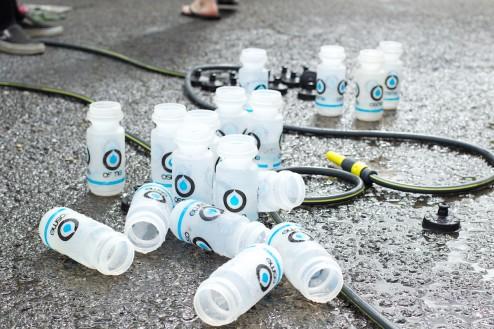Osmo Follow Up
If you missed our first two articles on Osmo Nutrition, they are located HERE and HERE.
Our first experience with Osmo included a semi-formal test that we took part in at a hotel in Boulder, CO. Chief researcher and co-founder of Osmo, Dr. Stacy Sims, hosted a group of athletes and journalists to compare Osmo against their normal drink and/or gel product of choice. We pointed out the parts of the test that we thought needed improvement, but had trouble entirely ignoring the output. For example, I don’t believe that there were any issues in their measurement of core body temperature (it was done via a core body temperature pill that every subject had to swallow a specific time before the test), and everyone’s core body temp was consistently lower with Osmo. That seemed quite significant to me.
Rather than relying on a single test to provide a verdict, we wanted to try the product for a season to see if it worked in the real world – and the race course. A key part of the Osmo product message has nothing to do with the product itself, but rather the other things you take in. Case in point – they suggest that you NOT look to liquid as a large source of calories; you should chew your calories in the form of food. Along with that, we were curious to see if there was anything to their choice of limited carbohydrate sources (glucose and sucrose), and the lack of artificial colors and ingredients. Put simply, it flies right in the face of almost every other sports drink in some way, shape or form.
This article serves as our season wrap-up. We’ll talk about what worked, what didn’t, and where we see the future of nutrition.

What Worked
The first thing about Osmo that worked for me is often the biggest ‘make or break’ aspect of a nutrition product – the taste. Osmo only has two flavors as of this writing (orange and blackberry), and I really like them both. The flavor is light and doesn’t disagree with many food combinations for me (i.e. drinking Osmo – not water – while eating solid food). Despite the high amount of electrolytes, it does not taste salty or strange.
Given the light taste and low concentration/osmolality, I found that I was able to drink a higher volume of fluid than I was used to. Based on my sweat rate and fluid throughput of the ‘lab’ test in Boulder, Dr. Sims gave me a recommended hourly fluid intake range of 26 to 39 ounces; I need to drink at least an entire large bike bottle per hour for all training and racing.
Finally, the biggest success of Osmo for me was the sugar type and ratio. For the full nerd-version of why Osmo picked what they did, take a look at our first two articles. I’ve tried a plethora of products that contain maltodextrin and/or fructose, and both have caused stomach upset for me. According to the folks at Osmo, both maltodextrin (manufactured from corn or wheat) and fructose (‘fruit sugar’) take longer to break down in your gut due to larger molecule size and the method of uptake.
The pattern I observed seems to make sense. At lower intensities, or at times that I’m more rested, my body deals with maltodextrin and fructose reasonably well (also – fiber, protein, fat, and anything else that doesn’t digest quickly). When the intensity level rises, I can’t deal as well with the complex ingredients. One physiologist explained it to me in the sense of ‘total resource’ that your body has available. If you’re redlined in a race or workout, low on sleep, stressed at work, etc – your body is going to do everything else – including digestion – at a reduced capacity.
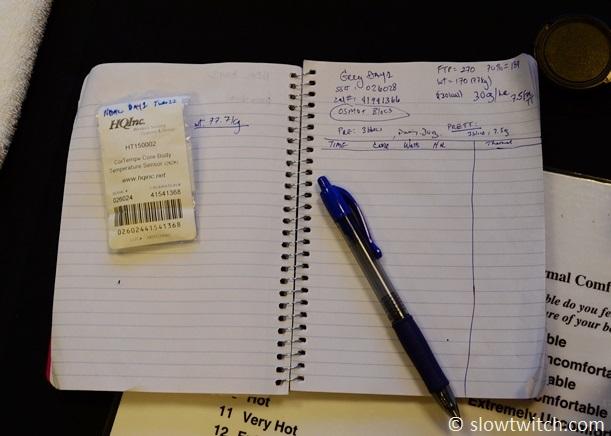
I ran this whole situation by one professional coach that wanted to remain anonymous due to a conflicting agreement with another nutrition company. According to this person, their observation over many years is that some athletes deal well with the modern ‘high-tech’ drinks that feature many sources of carbohydrate and/or amino acids – and a second group that clearly requires very simple sugars. They expressed that, science-be-damned, it just works out that way. After trying a ton of nutrition products, I seem to fall squarely in the second group.
Concentrating Osmo
I had a few people ask me about concentrating Osmo. If they got the sugars right, why not just load up the concentration and use it as your primary source of calories? We didn’t want to leave any stone unturned, so I did experiment with this for several weeks. At first glance, it made perfect sense for long-course racing. Just use a super-concentrate bottle, take a swig, and chase it with plain water from another bottle.
To make a long story short, it just didn’t work out for me. The strong concentration altered the taste, and I found myself drinking less over time. My stomach simply did not feel as settled with this approach, so I went back to standard concentration.
What Didn’t Work
While I enjoyed the two flavors of Osmo, I definitely found myself wanting more choices by the end of the summer. I think that they need at least two more if they really want to compete with other companies that have been around for a long time. The first choice is easy – some sort of lemon/lime flavor. Beyond that, who knows. Raspberry? Strawberry? Uncooked Pork Swirl? (bonus points for anyone who can identify the reference)
Another big part of the Osmo story is that they say you do NOT need to take salt tablets, due to the high amount of electrolytes in their products. I tried this over and over, but found that I still required electrolyte tabs. I’ve tried many types, and have settled on Succeed Caps as my favorite. They contain a LOT of sodium (341mg Na, equivalent to 867mg as sodium chloride).

Succeed Caps do not contain magnesium. I’ve used other salt tabs for a long time that do contain magnesium, and found myself needing to take ‘bathroom stops’ (yes, that kind of bathroom stop) from time to time in half-iron and iron-distance races. I read that magnesium can contribute to this in high concentrations, and my switch to Succeed Caps seemed to do the trick. Since making the switch this Spring, I’ve had nary a muscle cramp and zero pit-stops. Interestingly enough, Succeed Caps have both sodium bicarbonate and sodium citrate – which are the two preferred sources of sodium from Dr. Sims (the two companies have no association together).
How do I know that I need supplemental electrolytes? After doing endurance sports long enough, I can just feel it. If I’m feeling foggy or unmotivated for a workout, food and water have a mediocre success rate at bringing me around. One or two Succeed Caps almost always does the trick. Same deal during races – if I get behind on sodium, my motivation wanes and I slow down. I settled on 1 – 2 Succeed Caps per hour (depending on ambient temperature) in addition to what I get from Osmo. Note that this also assumes that I take in some amount of plain water, due to the realities of aid stations.
The final aspect of the Osmo plan that didn’t work for me is a little more complex. It’s the issue of getting your calories from solid food, not liquid.
My take is this: It works, but it is logistically difficult in certain situations. More specifically, it can be an inconvenience in training, and not possible in some race scenarios.
The training part really depends on your food preferences and your local ride routes. If you have stopping points that are frequent and sell the types of foods you like, you’re in the clear. If not, you must do significant planning ahead of time, and be willing to carry a lot of food. On more than one occasion, I set out for rides carrying no less than 120 ounces of fluid and a hydration pack full of food. The problem that this presents is that you cannot access jersey pockets nearly as easily, and must stop every time you want to eat (figure at least twice per hour). It works… it’s just a pain. A bento box almost becomes a necessary piece of equipment for everyday riding.
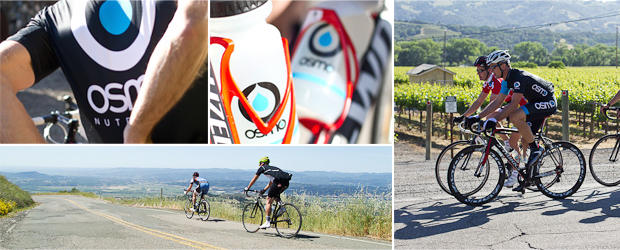
Racing with the ‘Osmo plan’ is, in my opinion, easy at distances up to half Ironman. You don’t have to take in that much solid food, don’t have to pick up much from aid stations, and can generally race your race without over-thinking it. I used it several times this year and had no problems.
It’s Ironman-distance that throws a wrench. Your hourly calorie intake goes up significantly and the logistics of Special Needs bags come in to play. The ease of execution also relies heavily on your bike setup. With sleek modern frames, our available real-estate for food and bottle placement is shrinking. After all, many of us want to race with a GPS unit, a bottle between the aerobars, a flat repair kit, and – by the way – it needs to be tucked away in a minimal fashion. Also, almost every bike company on the planet has decided that triathletes and time trialists don’t need to drink, and give you only one bottle mount on the frame.
Lucky for me, my bike has two bottle mounts, and I use them both. The deal-breaker became the requirement of solid food – I just couldn’t carry as much as I needed. I made a spreadsheet with my entire hourly intake for an Ironman, and it wasn’t going to fly (and I wasn’t going to wear a Camelbak and stop every 30 minutes).
In search of a solution, I ended up unearthing my now-favorite nutritional trick. It’s so good that I honestly hesitated to write about it, lest my competition find out. Here it is – unedited and reformatted in THX Surround Sound.
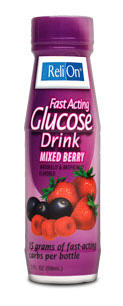
That’s right – you shop for these in the diabetes section of your local big-box store. Dr. Sims initially pointed me towards glucose tablets – the little round discs that you chew on. Each tube of ten tabs has 10 calories, and costs about a dollar.
Just out of curiosity, I bought a few liquid glucose shots. The main ingredients are glucose (dextrose), water, and artificial flavoring. They have 70 calories apiece; roughly the same as a gel pack. Months ago, I’d heard Mark Allen comment on nutrition during a podcast, and he noted that his race nutrition during the years he won Kona was primarily liquid, and primarily glucose. As we know, our body ultimately turns everything we eat into glucose… so why not just take in straight glucose and avoid all of the stomach work?
These little gems turned my luck right around. They don’t taste great, but they go down very quick. If you want to save some money, you can make them yourself using a gel flask, bulk dextrose powder, and a fruit powder of your choice (all available online).
The beauty is that they contain nothing to upset your stomach, and bring your blood sugar right up. It almost feels like cheating, if you ask me. I’ve consulted with many nutrition experts, and they all seem to agree – when you start to ‘low’ or weak during a race, it is often as simple as low blood sugar (or sodium, as mentioned above). You can never replace all of the calories you burn, and maintenance of blood sugar is the next best thing.
I used the glucose shots to fill in extra calories that I could not carry. Two shots fill a normal sized gel flask, which can be fixed to your top tube with these common devices:
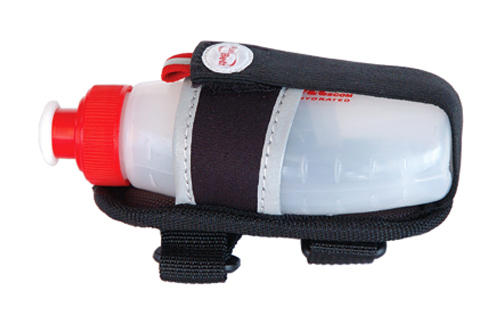
I now keep a couple of these in my gym bag at all times. If I am rushed to a workout without having eaten enough at the previous meal, these things can be the difference between a good session and a total failure.
Race Plan with Osmo
In our last article, we laid out a tentative Ironman nutrition plan with the help of Dr. Sims. I tweaked it over the summer based on shorter races and the foods I learned worked best for me. Below, I’ll post the spreadsheet of what I actually raced with at Ironman Mont-Tremblant.

Here are my notes, in no particular order
1. Bike intake is accurate in terms of total consumption. That is everything I took in. The exact timing of each item is not necessarily accurate (i.e. I ate a few Clif Bloks, then had a couple cookies, then went back to Clif Bloks). Actual bike time was about 5:15, or about 400kcal/hour. I raced with two large Specialized Purist (26 oz) bottles on the frame, and no behind-the-seat or between-the-aerobar bottles.
2. Run intake – I’m not 100% confident of my intake during the last hour of the race (my brain was foggy by that point). I ran just over 3:30, and figure I took in about 300kcal/hour.
3. I had absolutely zero stomach problems. No cramping, bloating, flavor fatigue, vomiting, unwanted bathroom stops, or anything of the sort.
4. Along with the glucose shots, peppermint Tums (regular strength) are my new go-to race secret. They do a wonderful job of settling my stomach, especially during the run. In the past, I’d always dial back my calorie intake to settle my stomach… now I am able to shove more food in if I take a couple Tums per hour, especially during the run. It works.
5. My cookie choice for this race was Enjoy Life soft baked cookies – 60kcal each. They’re easy to chew, and taste great.
6. Was it a PR? How did you do? My finishing time was 9:54, and it was about 35 minutes slower than my PR. That’s not for bragging rights (I got it absolutely handed to me in my division), but just as a note of relative speed. I chalk my less-than-stellar time up to a few things – difficult course (my PR was on a flat course), a very busy summer, and a subsequent lack of fitness. I just wasn't prepared. Coming from someone with a history of nutrition woes, I was able to remove the nutrition from the equation entirely, and race right up to the potential I had. At this time, I see no inherent problem with this nutrition approach if I had been an hour faster or seven hours slower.
7. Was the nutrition plan difficult? Was it enjoyable? This is something that is going to be individual, but I really enjoy it. Even ignoring the taste aspect, it is very nice to have figured out a plan that works for me and does not include GI distress and cramping. It’s a rolling buffet of foods that I like. I had a nice ride with Tim DeBoom this Spring at a Shimano event, and he said that during his most successful Ironman races, he tends to be eating something almost constantly.
8. How did you end up with your food choices? Trial and error over many years, and the advice of Dr. Sims. Where I sit right now, here are my basic criteria – A) gluten free, B) low fiber, C) little-to-no protein or fat, D) easy to transport and chew. Within those confines, it’s hard to go wrong. Pink Lemonade Honey Stinger chews seem to never get old and I can easily eat them while running. During training, I mix it up with gluten-free sandwiches, crackers, and a variety of candy.
9. What about the last half of the run – you didn’t drink any Osmo! This is very true. Over the course of the summer, I found that if I at least started the race with full bottles of Osmo and the right food choices, I could switch to course nutrition in at the end of the race and do okay. Osmo does not advertise with Slowtwitch, did not pay for these stories, or anything of the sort. I’m an editor, but I’m also an athlete – and it is very exciting to the athlete side to finally find something that works. I’m most definitely very open to using other brands, provided they work just as well for me.
Future of Nutrition
Where is triathlon nutrition going? Clearly the low osmolality and low calorie trend is coming on strong, with products such as Skratch, Nuun, SOS, Fluid, and others.
One option that some people take is making their own mix. It could definitely save money, but I have to think it would be a huge experiment to try to match the exact formula and taste of existing products. You could reverse engineer it based on the nutrition-per-serving, flavor it to suit your needs, and have fun beating the system. While I’m all for saving money, I don’t think I’ll be trying this any time soon.
My guess is that we’ll see existing companies take sides. If a company currently sells ONLY multi-source complex carb gels and powders, I don’t see them all-of-a-sudden offering something like Osmo. On the flip side, I don’t see a company with marketing based on low-concentration drinks offering a thick gel. Perhaps they’ll prove me wrong. With the products being so different, it would be difficult to have a marketing plan that does justice to both.
I think the key take-home for Joe Triathlete is this: If one plan isn’t working for you, try something else. The key is to not just try another iteration of the same plan. If one brand of drink doesn’t work, a blind shot at another brand won’t do you any good. Both drinks could be made of the same ingredients and similar concentration. Ingredients are easy to see; it’s the osmolality that’s tough. Most drinks simply do not list it. My advice is to isolate the two key parts – concentration and carbohydrate source. A possible third is the use of any fat or protein. Control for each variable until you find a formula that works.





